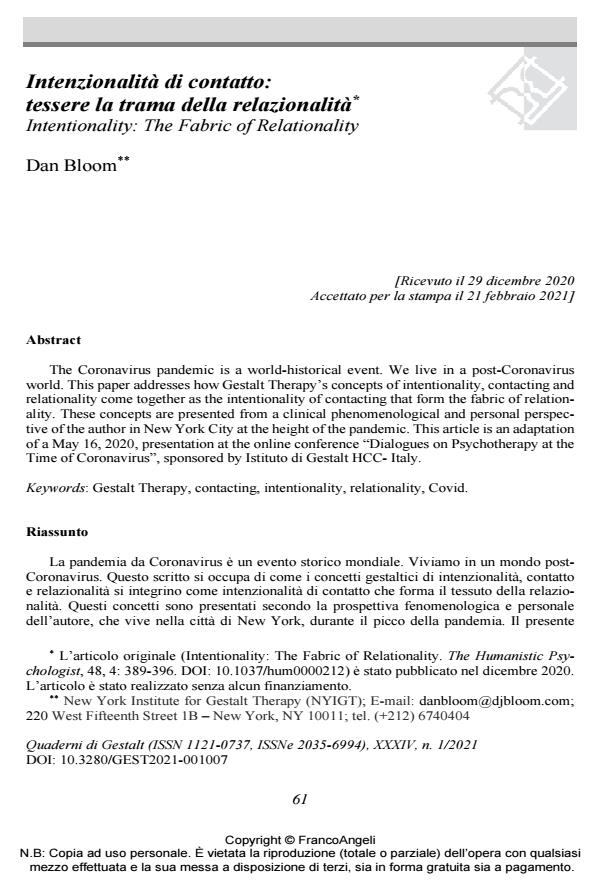Intenzionalità di contatto: tessere la trama della relazionalità
Titolo Rivista QUADERNI DI GESTALT
Autori/Curatori Dan Bloom
Anno di pubblicazione 2021 Fascicolo 2021/1 Lingua Italiano
Numero pagine 12 P. 61-72 Dimensione file 187 KB
DOI 10.3280/GEST2021-001007
Il DOI è il codice a barre della proprietà intellettuale: per saperne di più
clicca qui
Qui sotto puoi vedere in anteprima la prima pagina di questo articolo.
Se questo articolo ti interessa, lo puoi acquistare (e scaricare in formato pdf) seguendo le facili indicazioni per acquistare il download credit. Acquista Download Credits per scaricare questo Articolo in formato PDF

FrancoAngeli è membro della Publishers International Linking Association, Inc (PILA)associazione indipendente e non profit per facilitare (attraverso i servizi tecnologici implementati da CrossRef.org) l’accesso degli studiosi ai contenuti digitali nelle pubblicazioni professionali e scientifiche
La pandemia da Coronavirus è un evento storico mondiale. Viviamo in un mondo post-Coronavirus. Questo scritto si occupa di come i concetti gestaltici di intenzionalità, contatto e relazionalità si integrino come intenzionalità di contatto che forma il tessuto della relazionalità. Questi concetti sono presentati secondo la prospettiva fenomenologica e personale dell’autore, che vive nella città di New York, durante il picco della pandemia. Il presente articolo è l’adattamento di una presentazione ad una conferenza online, "Dialoghi sulla psicoterapia ai tempi del Coronavirus", tenutasi il 16 maggio 2020 e organizzata dall’Istituto di Gestalt HCC Italy.;
Keywords:Psicoterapia della Gestalt, contatto, intenzionalità, relazionalità, Coronavirus.
- Bloom D. (2016). The Relational Function of Self: Self Function on the Most Human Plane. In: Robine J.-M. (ed.), Self: A polyphony of contemporary gestalt therapists. St Romain laVirvèe, France: L’Exprimerie, pp. 65-84 (trad. it.: La funzione relazionale del sé. Il funzionamento del sé sul piano più umano. In: Robine J.-M. (a cura di), Sé. Una polifonia di psicoterapeuti della Gestalt contemporanea. Milano: FrancoAngeli, 2018, pp. 56-77).
- Bloom D. (2019a). From Sentience to Sapience: The Awareness-consciousness Continuum and the Lifeworld. Gestalt Review, 23, 1: 18-43.
- Bloom D. (2019b). Gestalt Therapy and Phenomenology: The Intersection of Parallel Lines. In: Brownell P. (ed.), Handbook for Theory, Research, and Practice in Gestalt therapy. Cambridge, UK: Cambridge Scholars Publishing, pp.183-202.
- Brentano F. (2015). Psychology from an Empirical Standpoint. London, UK: Routledge (trad. it.: La psicologia dal punto di vista empirico. Bari: Laterza, 1997).
- Carr D. (2014). Experience and History: Phenomenological Perspectives on the Historical World. Oxford, UK: Oxford University Press.
- Crocker S.F. (2009). Phenomenology in Husserl and Gestalt Therapy. British Gestalt Journal, 18,1: 18-28.
- Francesetti G. (2015). From Individual Symptoms to Psychopathological Fields: Towards a Field Perspective on Clinical Suffering. British Gestalt Journal, 24, 1: 5-19. (ed. or.: Dalla sintomatologia individuale ai campi psicopatologici. Verso una prospettiva di campo sulla sofferenza clinica. Quaderni di Gestalt, XXVII, 2: 31-56. DOI: 10.3280/GEST2014-002003)
- Frank R. (2016). Self in Motion. In: Robine J.-M. (ed.), Self: A Polyphony of Contemporary Gestalt Therapists. St Romain laVirvèe, France: L’Exprimerie, pp. 371-386 (trad. it.: Il sé in movimento. In: Robine J.-M. (a cura di), Sé. Una polifonia di psicoterapeuti della Gestalt contemporanea. Milano: FrancoAngeli, 2018, pp. 382-398).
- Gurwitsch A. (1974). Phenomenology and the Human Sciences. Evanston, IL: Northwestern University Press.
- Heidegger M. (1962). Being and Time. New York, NY: Harper & Row (trad. it.: Essere e tempo. Milano: Longanesi, 1976).
- Humphrey K., Bloom D. (2018). Contact Interruptions. Gestalt Review, 22, 1: 91-106.
- Husserl E. (1973). Logical Investigations. London, UK: Routledge (trad. it.: Ricerche logiche. Milano: Il saggiatore, 1968).
- Husserl E. (1981). “Phenomenology,” Edmund Husserl’s Article for the Encyclopedia Britannica (1927), In: McCormick P., Elliston F. (eds.), Husserl: Shorter Works. Notre Dame, Ind.: University of Notre Dame Press, 1981, pp. 21-35.
- Husserl E. (1999). Cartesian Meditations: An introduction to Phenomenology. Dordrecht, Holland: Kluwer Academic Publishers.
- Levinas E. (1969). Totality and Infinity: An Essay on Exteriority. Pittsburgh, Pennsylvania: Duquesne University Press (trad. it.: Totalità e infinito: Saggio sull’esteriorità. Milano: Jaca Book Editore, 1986).
- Lichtenberg P. (2012). Inclusive and Exclusive Aggression: Some (Gestalt) Reflections. Gestalt Review, 16, 2: 145-161.
- McIntyre R., Smith, D.W. (1989). Theory of Intentionality. In: Mohanty J.N., McKenna W.R. (eds.), Husserl’s Phenomenology: A Textbook. Washington, D.C.: Center for Advanced Research in Phenomenology and University Press of America, pp. 147-179.
- Perls F.S. (1969). Ego, Hunger and Aggression. New York, NY: Basic Books (trad. it.: L’io, la fame, l’aggressività. Milano: FrancoAngeli, 1995).
- Perls F.S., Hefferline R., Goodman P. (1951). Gestalt Therapy: Excitement and Growth in the Human Personality. New York, NY: The Gestalt Julian Press (trad. it.: La terapia della Gestalt: eccitazione e accrescimento nella personalità umana. Roma: Astrolabio, 1971;1997).
- Philippson P. (2001). Self in Relation. New York, NY: The Gestalt Journal Press.
- Spagnuolo Lobb M. (2007). Ego, Hunger and Aggression: Do We Bite in the Same Way as in the 50s? A Contribution to the Development of the Concept of Aggression in Gestalt Therapy Theory and Practice. Gestalt Review, 11, 3: 239-243.
- Spagnuolo Lobb M. (2013). The Now-for-Next in Psychotherapy: Gestalt Therapy Recounted in Post-Modern Society. Siracusa: Istituto di Gestalt HCC Italy Publ. Co. (ed. or.: Il now-for-next in psicoterapia. La psicoterapia della Gestalt raccontata nella società post-moderna. Milano: FrancoAngeli, 2011).
- Spiegelberg H. (1972). Phenomenology in Psychology and Psychiatry. Evanston, IL: Northwest University Press.
- Waldenfels B. (2016). The Question of the Other: The Tang Chun-I Lecture for 2004. Albany: SUNY Press.
- Waldenfels B., Kozin A., Stähler T. (2011). Phenomenology of the Alien: Basic Concepts. Evanston, IL: Northwestern University Press.
- Zahavi D. (2005). Subjectivity and Selfhood: Investigating the First-person Perspective. Cambridge, MA: MIT Press.
- Zahavi D. (2018). Collective Intentionality and Plural Pre-reflective Self-awareness. Journal of Social Philosophy, 49, 1: 61-75.
Dan Bloom, Intenzionalità di contatto: tessere la trama della relazionalità in "QUADERNI DI GESTALT" 1/2021, pp 61-72, DOI: 10.3280/GEST2021-001007